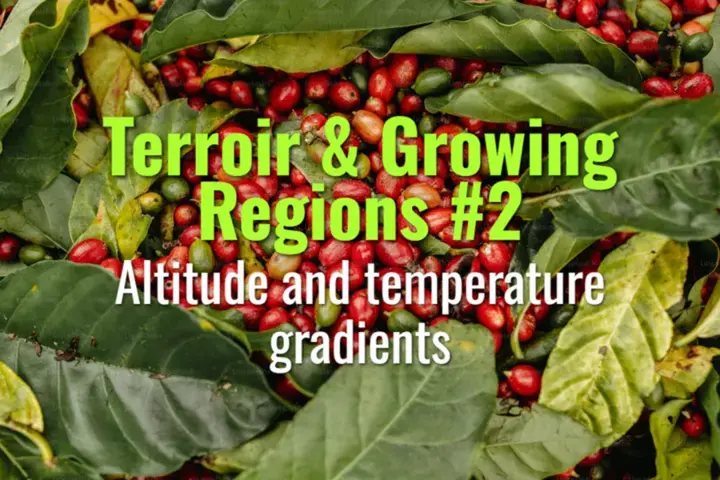Altitude and temperature gradients
This topic explains how altitude and temperature gradients shape coffee growth, yield, and flavor, and why these environmental factors are crucial to terroir and quality expression.
- Coffee Basics Nerds
- 2 min read
Article 2 of 12 in Terroir & Growing Regions/

Altitude Effects
- High altitude (1,200–2,200 m, mostly Arabica):
- Cooler temperatures slow cherry maturation.
- Denser beans with greater complexity and acidity.
- Enhanced floral, fruity, and citrus notes.
- Greater frost risk and lower yields.
- Mid altitude (800–1,200 m):
- Balanced growth, moderate bean density.
- Milder cup profiles with sweetness but less complexity.
- Low altitude (<800 m, often Robusta):
- Faster maturation, higher yields.
- Larger beans, lower density.
- Strong, earthy, bitter flavors with less acidity.
Temperature Gradients
- Arabica optimal: 18–22°C (stress above 24°C, damage below 12°C).
- Robusta optimal: 22–30°C, tolerates higher heat and humidity.
- Effects of heat:
- Accelerates cherry development → smaller beans, less sugar accumulation.
- Reduces acidity and cup complexity.
- Effects of cold:
- Frost causes leaf necrosis and tree death in sensitive areas.
- Delayed flowering, irregular fruit set.
Interplay of Altitude & Temperature
- Higher altitude compensates for equatorial heat, enabling Arabica to thrive near the equator.
- Farther from the equator, Arabica can grow at lower altitudes where temperatures remain cool.
- Example: Colombia’s Arabica thrives above 1,200 m, while Mexico’s Arabica can grow at ~700 m due to cooler latitude.
Flavor Correlations
- High-altitude Arabica: Bright acidity, floral and fruity notes, complex cup.
- Mid-altitude Arabica: Balanced body and sweetness.
- Lowland Robusta: Heavy body, strong bitterness, high caffeine.
Agricultural Implications
- Farmers must align cultivar choice with local altitude–temperature conditions.
- Climate change may push cultivation higher up slopes.
- Breeding programs seek varieties tolerant of warmer conditions without quality loss.
Lasting Importance
Altitude and temperature gradients are fundamental terroir variables, directly shaping cup quality, yield, and farming viability. They explain why coffee from the same cultivar expresses different flavors depending on where it is grown.
You might also like:
- Tags:
- Lasting Importance
- Cup Quality
- Climate Change
- High Altitude
- Cup Profiles
- Bright Acidity
- Lower Yields
- Body Sweetness
- Heavy Body
- Floral Fruity
- Higher Yields
- Breeding Programs
- Denser Beans
- Bean Density
- Fruit Set
- Cherry Maturation
- Agricultural Implications
- Acidity Floral
- Quality Loss
- Fruity Notes
- Smaller Beans
- Lower Altitudes
- Low Altitude
- Maturation Denser
- Beans Lower
- Larger Beans